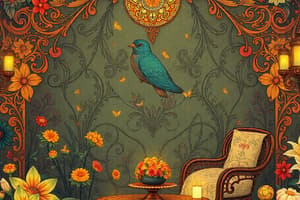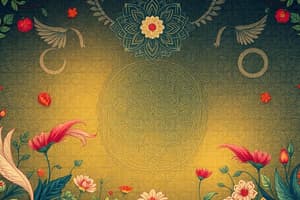Podcast
Questions and Answers
What does the acronym HSV stand for in color production?
What does the acronym HSV stand for in color production?
- Hue, Saturation, Vividness
- Hue, Saturation, Value (correct)
- Hue, Saturation, Viscosity
- Hue, Shade, Value
Hue refers to the brightness of a color.
Hue refers to the brightness of a color.
False (B)
What is the traditional technique of separating colors in commercial printing called?
What is the traditional technique of separating colors in commercial printing called?
Color separations
In color production, CMYK stands for Cyan, Magenta, Yellow, and __________.
In color production, CMYK stands for Cyan, Magenta, Yellow, and __________.
Which type of image contains only black and white with no shades of gray?
Which type of image contains only black and white with no shades of gray?
Computer printers always require color separation to print images.
Computer printers always require color separation to print images.
Match the color production term with its description:
Match the color production term with its description:
To print a continuous tone image on a conventional printing press, it must be converted to a __________.
To print a continuous tone image on a conventional printing press, it must be converted to a __________.
What are the three primary colors of light in the additive color model?
What are the three primary colors of light in the additive color model?
Subtractive color mixing results in white light.
Subtractive color mixing results in white light.
What does the RGB color model represent?
What does the RGB color model represent?
The subtractive color model uses the primary pigment colors: ______, ______, and ______.
The subtractive color model uses the primary pigment colors: ______, ______, and ______.
Match the following color models with their applications:
Match the following color models with their applications:
What is formed when the primary colors of pigment (cyan, magenta, and yellow) are mixed at full intensity?
What is formed when the primary colors of pigment (cyan, magenta, and yellow) are mixed at full intensity?
In the RGB model, the maximum intensity of colors is measured on a scale of 0 to 255.
In the RGB model, the maximum intensity of colors is measured on a scale of 0 to 255.
What is the purpose of adding black (K) in the CMYK color model?
What is the purpose of adding black (K) in the CMYK color model?
What is the purpose of superimposing different screening percentages in printing?
What is the purpose of superimposing different screening percentages in printing?
A black formed by 100% of all the inks will have an intense black color.
A black formed by 100% of all the inks will have an intense black color.
What method can be used to create an intense black color without technical problems?
What method can be used to create an intense black color without technical problems?
Six-color printing includes modified versions of cyan, magenta, yellow, plus ________ and ________.
Six-color printing includes modified versions of cyan, magenta, yellow, plus ________ and ________.
Why is stochastic screening preferred for six-color printing?
Why is stochastic screening preferred for six-color printing?
Match the following methods of color creation with their descriptions:
Match the following methods of color creation with their descriptions:
The composition required for each spot color is specified in a color guide.
The composition required for each spot color is specified in a color guide.
What can cause moire problems in six-color printing?
What can cause moire problems in six-color printing?
Flashcards
HSV Color Model
HSV Color Model
A color model that describes colors based on three aspects: hue, saturation, and value.
Hue
Hue
The dominant wavelength of a color, giving it its unique name (e.g., red, blue, yellow).
Saturation
Saturation
The intensity or purity of a color. High saturation means a strong, vivid color, while low saturation means a more muted or grayed color.
Value
Value
Signup and view all the flashcards
Color Separations
Color Separations
Signup and view all the flashcards
Halftone
Halftone
Signup and view all the flashcards
CMYK Printing
CMYK Printing
Signup and view all the flashcards
Halftone Screen Angle
Halftone Screen Angle
Signup and view all the flashcards
Perception of Color
Perception of Color
Signup and view all the flashcards
Color Production
Color Production
Signup and view all the flashcards
Additive Color
Additive Color
Signup and view all the flashcards
Subtractive Color
Subtractive Color
Signup and view all the flashcards
CMYK Color Model
CMYK Color Model
Signup and view all the flashcards
Color Intensity
Color Intensity
Signup and view all the flashcards
Printing Black (K)
Printing Black (K)
Signup and view all the flashcards
Rich Black
Rich Black
Signup and view all the flashcards
Setoff Problem
Setoff Problem
Signup and view all the flashcards
Six Color Printing
Six Color Printing
Signup and view all the flashcards
Spot Color
Spot Color
Signup and view all the flashcards
Moire Pattern
Moire Pattern
Signup and view all the flashcards
Stochastic Screening
Stochastic Screening
Signup and view all the flashcards
Color Guide
Color Guide
Signup and view all the flashcards
Study Notes
Color in Production
- Color theory involves the interaction of light, the object, and the observer
- Light illuminates the object, which reflects light to the observer
- The observer perceives the reflected light as color
Additive Color
- White light is formed by mixing red, green, and blue light
- Adding these colors together creates white light
- This is known as additive color
Subtractive Color
- Objects that don't emit light obtain color from the pigments they contain
- The three primary pigment colors are cyan, magenta, and yellow
- Combining these pigments subtracts reflected light, resulting in black
RGB Color Model
- A color model based on additive color mixing of red, green, and blue light
- Used in devices like TVs, monitors, and projectors
- Color intensity is measured on a scale of 0 to 255
- White is represented by (255, 255, 255)
CMYK Color Model
- A subtractive color model used in color printing
- The primary colors are cyan, magenta, yellow, and black
- Combining these pigments produces a full-color image
- Black is often added as a separate "key" color (K) to improve the intensity and reduce color problems
HSV (Hue, Saturation, Value)
- A perceptual color model based on hue, saturation, and value
- Hue corresponds to the dominant wavelength of a color (e.g., red, blue, yellow)
- Saturation represents the purity of the color
- Value (brightness) represents the percentage of reflected light
Color Separations
- Traditional technique for separating full-color art into halftone negatives (cyan, magenta, yellow, and black)
- Used in commercial printing
- Computer-based illustration software often automates this process
- Specialized printers (dye sublimation, inkjet, laser) may not require color separations
Image Types
- Line art images contain only black and white
- Continuous tone images contain shades of gray or color
Halftones
- Technique used to print continuous tone images
- Screens created by a pattern of variable-size dots
- Create an impression of tones with one ink color
Angles for Color Separations
- Color separation screens need to be placed at different angles to prevent moire patterns
- Moire patterns are visual distortions that occur due to overlapping screens
Spot Color (Flat Ink)
- Color produced outside the printing machine by mixing basic inks
- Color composition is specified in color guides (like Pantone)
- Usually used for logos, duotone images, or other graphic elements that require specific colors.
Four-Color Printing (CMYK)
- Uses cyan, magenta, yellow, and black for color reproduction
- Black (K) is often combined with other colors for optimal color intensity without technical problems
Six-Color Printing
- Using additional colors (like modified cyan, magenta, yellow, black, green, or orange) improves the color range
- Stochastic screening is commonly used, eliminating moire patterns
Studying That Suits You
Use AI to generate personalized quizzes and flashcards to suit your learning preferences.




